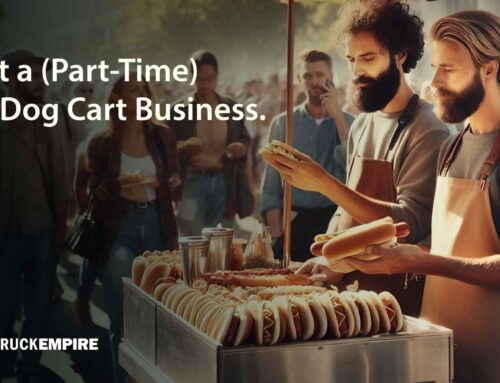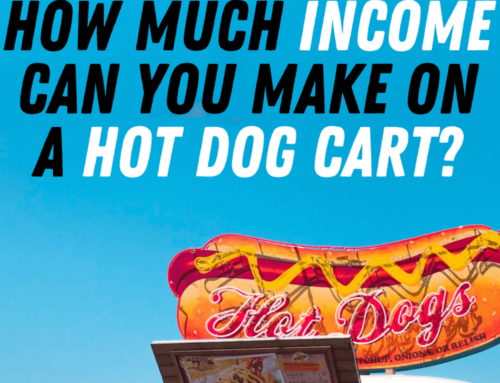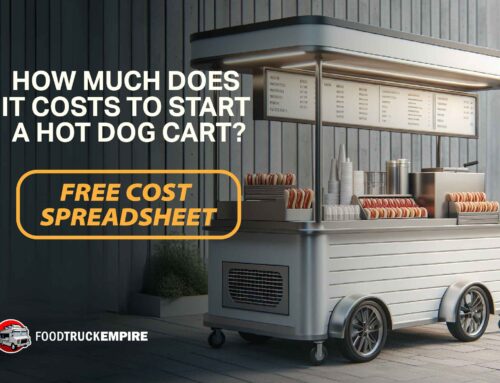Podcast: Play in new window | Download | Embed
Subscribe: RSS
In today’s podcast episode Matt Gladfelter of Bow Ties and HotDogs shares his list of the pros and cons of operating a hot dog business. As with any business models there are plenty of good things and bad things you should be aware of before getting started.
You may already be aware of many advantages of this business so let’s start out with some of the downsides of operating a hot dog cart first. Let’s get into it.
Disadvantages

It’s more than selling sausages.
Harder Work Than You Might Think. Anytime you want to generate an income, you’ll physically go outside, prepare your cart for service and vend to make money. This includes a setup process that will usually take 30 minutes of prep to get signage up, your umbrella out, and the grill turned on and ready to sling hot dogs. (This of course assumes you haven’t hired an employee to do the work for you.)
After your long day of vending is complete, you’ll need to clean up your area. You’ll also need to pack everything back up and into your vehicle again to haul home or to the commissary. You’ll also need to do some basic bookkeeping to record sales and check inventory levels. If inventory is low, you’ll need to go shopping to make sure you’ve got enough sausages, chips, sodas, buns, utensils, napkins and condiments for the next shift.
Withstanding the Elements – Unless you operate a hot dog truck (which can still be hot in the summer!), you will need to be prepared to withstand anything that mother-nature throws your way. A perfectly blue sky can quickly transform into rain clouds depending on where you live.
As mentioned in the interview, this most recent summer in Tennessee where temperatures regularly went up to 95 degrees and that doesn’t factor in the humidity. On the flip-side hot dog vendors in places like Chicago and New York operate year round and experience hot summers and brutally cold winters. There’s a certain level of toughness you must have to be successful.
Dealing with Public – Anytime you operate a customer service based business, including a hot dog stand you will encounter challenging people. Eventually, someone is going to complain about the quality, taste or temperature of their hot dog… Even if nothing is wrong with the product.
If you end up serving at a beer garden or bar, you’ll inevitably need to deal with folks that have had too much to drink. These situations can be challenging and it’s your job to maintain a level of professionalism and coolness factor even when someone else is not being nice. You can influence the types of people you meet depending on when and where you vend, but dealing directly with all sorts of different people can be tough.
“It’s a rollercoaster, really.” says Matt Gladfelter. “One minute you’re getting praised for the ‘best hot dog in town’, and the next, you’ve got someone grumbling that their mustard-to-ketchup ratio isn’t up to their standards. It’s like being a chef, a customer service rep, and a therapist all at once.”
Rent or Lease a Vending Location – You can’t just pull your hot dog cart up to any busy street or side walk and start vending. And vending often isn’t a free activity. Most organizers charge a fee of hundreds of dollars or a percentage of the sales to vend at festivals or festivals. If you want to setup your stand in front of a gas station or outside of a bar, you might need to pay the owner of the property monthly rent to vend there. Keep this bit of overhead in mind before getting started so you can better estimate profitability of the business.
Unpaid Work: Operating a hot dog cart involves several tasks beyond the immediate vending activities, many of which are often unseen and unpaid but are crucial for the success of the business. This work can include publishing promotion content on social media websites, working with catering clients, menu planning, inventory management, and planning a new vending route, or other administrative tasks.
Advantages
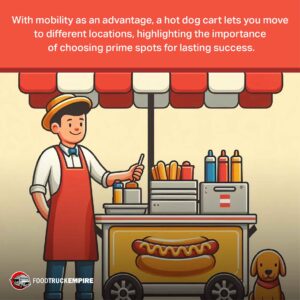
Mobility is an advantage.
Control Your Time – This is a big one for Gladfelter as he explains in today’s podcast episode. Gladfelter got to spend the whole summer with his kids since he had such a flexible schedule. If you need to take off due to a kids baseball game, go ahead and shut down the cart for the afternoon and attend.
This type of business unlike just about any other in the food industry is unique that you can operate around your schedule. With a restaurant, you’ve got a set amount of hours you need to be open for each day. That’s not that case with a cart.
Low Cost to Get Started – We’ve discussed this before, but Gladfelter was able to start his hot dog cart business for less than a $5,000 initial investment. He has purchased an upgraded cart with all the bells and whistles since that time, but he was able to prove the model to himself and the business plan by doing this.
There are not many real business you can get into for under $10,000. From there success or failure is largely determined by how much hustle you put into the operation. “Compared to running a restaurant, my overheads are a joke. No rent for a big space, no huge utility bills. It’s just me and my cart.” says Gladfelter.
Ability to Scale – If you have aspirations of making really large sums of money beyond the $100,000 per year revenue mark, your business needs to be able to scale. With a hot dog business this is a real possibility because adding new carts isn’t going to break the bank once you start generating an income. If you want earn more, just add another cart and hire someone to operate it. There are some business owners that over the period of a few years have added over 100 carts. Just imagine how much income you could generate with even a small amount of net profit being generated from these vehicles on a daily basis.
Related Reading: Total Cost Breakdown for Hot Dog Business Startups
Your job will become significantly different if growing your business is the goal. Instead of focusing your time on operating a single cart, your focus will be on managing people and making sure you’ve got systems in place to train new vendors you bring into the system. Still, it’s reassuring to have a business that you know can grow if you want it to.
Mobility and Location Choice: Gladfelter says, “If one spot isn’t working out, I just roll to another. This business is all about fishing where the fish are.” If you put in the work to find quality locations that pay well week in and week out, you can build a nice business for yourself that will cover expenses for years to come.
Supplemental Income: Tips can significantly supplement your income. They are a direct reflection of customer satisfaction and can add up, especially during busy periods or special events. These can really enhance the profitability of a hot dog cart. Make sure to leave out a tip jar and you could easily generate an extra 10% – 20% in profit from every event.
Building Relationships: As a vendor, you’re more than just a business; you become a familiar face in the neighborhood. You get to know people’s names, their usual orders, and bits about their lives. This builds a sense of community and loyalty. It’s like being a part of a big neighborhood family.
Licenses and Health Permits
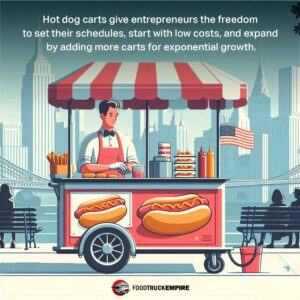
It gives entrepreneurs the freedom.
It’s important to remember that you can’t just buy a hot dog cart and start slinging dogs at any roadside location you find. You’ve got to make sure you’ve got the appropriate licenses and health permits to be able to sell safely in your area.
- Business License: Think of this as your entry ticket to the world of commerce. It’s like when you buy a ticket to a baseball game; it’s your permission to enter the stadium and enjoy the game. Similarly, a business license allows you to legally operate your business in your city or town. Most vendors start as a sole proprietor or form an LLC.
- Food Vendor’s License: This is akin to getting a driver’s license. Just as you need a license to drive a car on public roads, you need a food vendor’s license to sell food to the public. It’s proof that you’ve met certain standards and are qualified to operate your food cart. Head to Google and search for food vendor license + your city or state to get more information about this requirement. Here’s the application process to get a food vendor’s license in Boise as an example.
- Health Department Permit: Now, this is crucial. It’s like getting a seal of approval from a doctor for being fit. A health department permit ensures your hot dog cart meets health and safety standards. It’s like ensuring the baseball game you attend is safe and enjoyable, without any health risks.
- Fire Department Certificate: If you’re using propane or any other flammable material, this is a must. It’s like having a fire extinguisher in your home; a precautionary measure to ensure safety against fire hazards. Not all cities will require this type of certificate or inspection, but many do.
- Commissary Letter of Agreement: This is quite unique to food carts. Think of a commissary as your home base, where you store and prep your food. It’s like having a garage where you park and maintain your car. A letter of agreement with a commissary is often required to ensure you have a clean, sanitary place for food preparation and storage. Again, not all cities will require you to operate out of a commissary since hotdogs are a lower risk food to serve.
- Sales Tax Permit: If your state charges sales tax, this permit is like keeping a scorecard in baseball. It’s how you keep track of the sales tax you collect from customers, to be remitted to the government.
- Food Handler’s Permit: This is for you and any employees. Just like players need to know the rules of the game, anyone handling food in your business needs to understand food safety. This permit is proof of that knowledge. More often than not you can get your food handler’s permit online in a few hours. The cost is generally low for this permit too.
While this doesn’t fall under licenses, you’ll also need to provide proof of insurance on a hot dog cart to acquire a vendors license. The amount of insurance a hot dog cart vendor needs can vary depending on several factors, such as location, the size of the operation, and the specific risks involved. However, here are some general guidelines:
- General Liability Insurance: This is the most basic and essential type of insurance. It protects against claims of bodily injury or property damage that your hot dog cart might cause to others at a festival or other event. The typical coverage amount can range from $1 million to $2 million. Think of it as a safety net, similar to wearing a seatbelt while driving.
- Product Liability Insurance: This covers you in case someone gets sick from eating your hot dogs. Given the nature of food service, this insurance is particularly important. Coverage amounts are often similar to general liability insurance.
- Property Insurance: If you own a more expensive cart or have a lot of equipment, property insurance can protect against loss or damage to your hot dog cart. It’s like having homeowner’s insurance for your cart.
Quotes from the Show
Your scale of growth is limited to your imagination, to think outside the box a little, and to create a great brand and experience for your guests. – Matt Gladfelter the growth potential for this business model.
It is an exciting way to live, but it’s not for everyone. – Matt Gladfelter on operating a hot dog business.
There’s a reason there’s a lot of used hot dog carts on Craigslist. I think that’s because a lot of people do ignore the fact that this is hard work. – Matt Gladfelter getting real about how much work it is to operate a vending business.
Related Resources
Hot Dog Business Plan – Ready to start your own hot dog cart? Learn how to create a business plan and conduct market research in your area.
How much income can you make on a hot dog cart? – Find out if you can actually make a decent living in this type of business.




